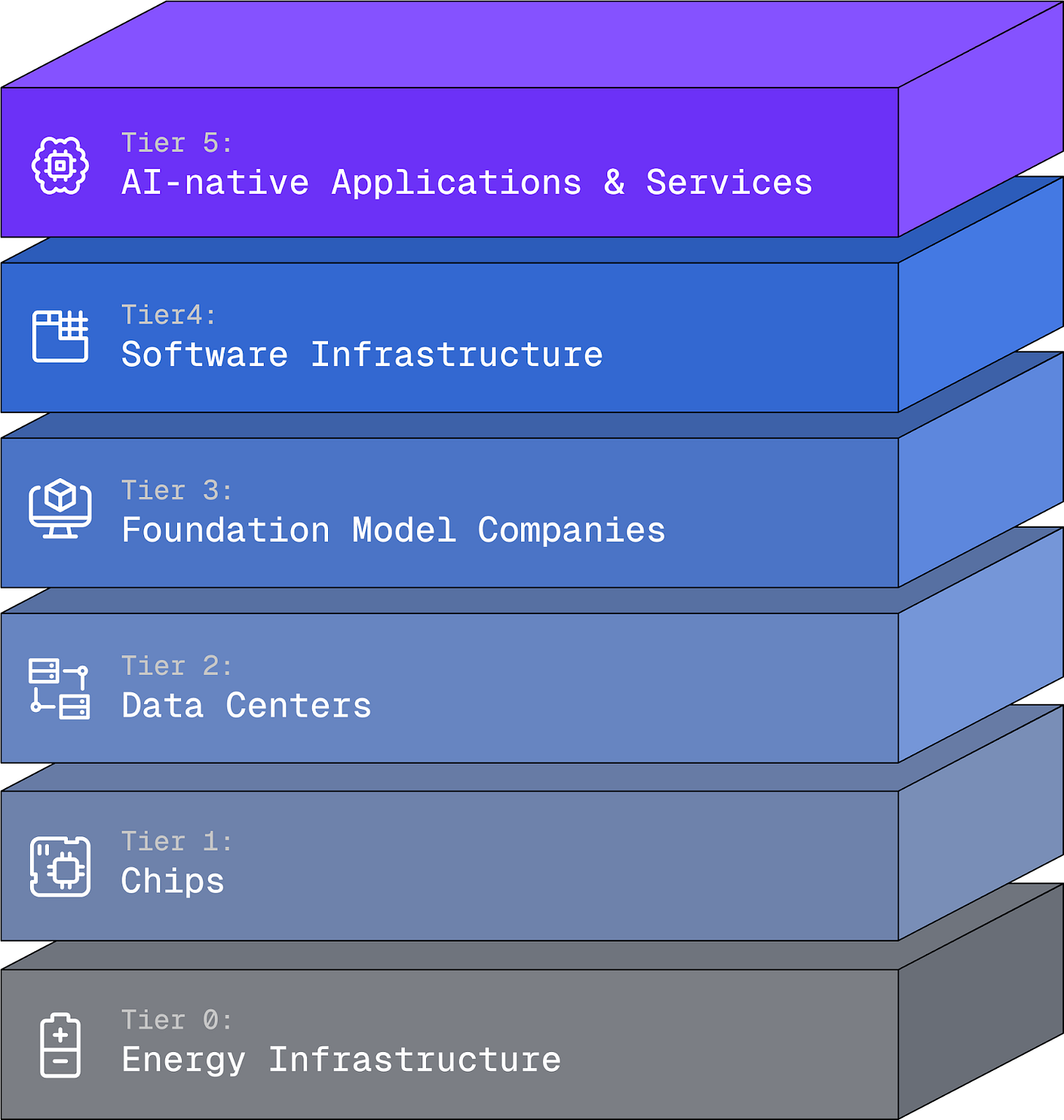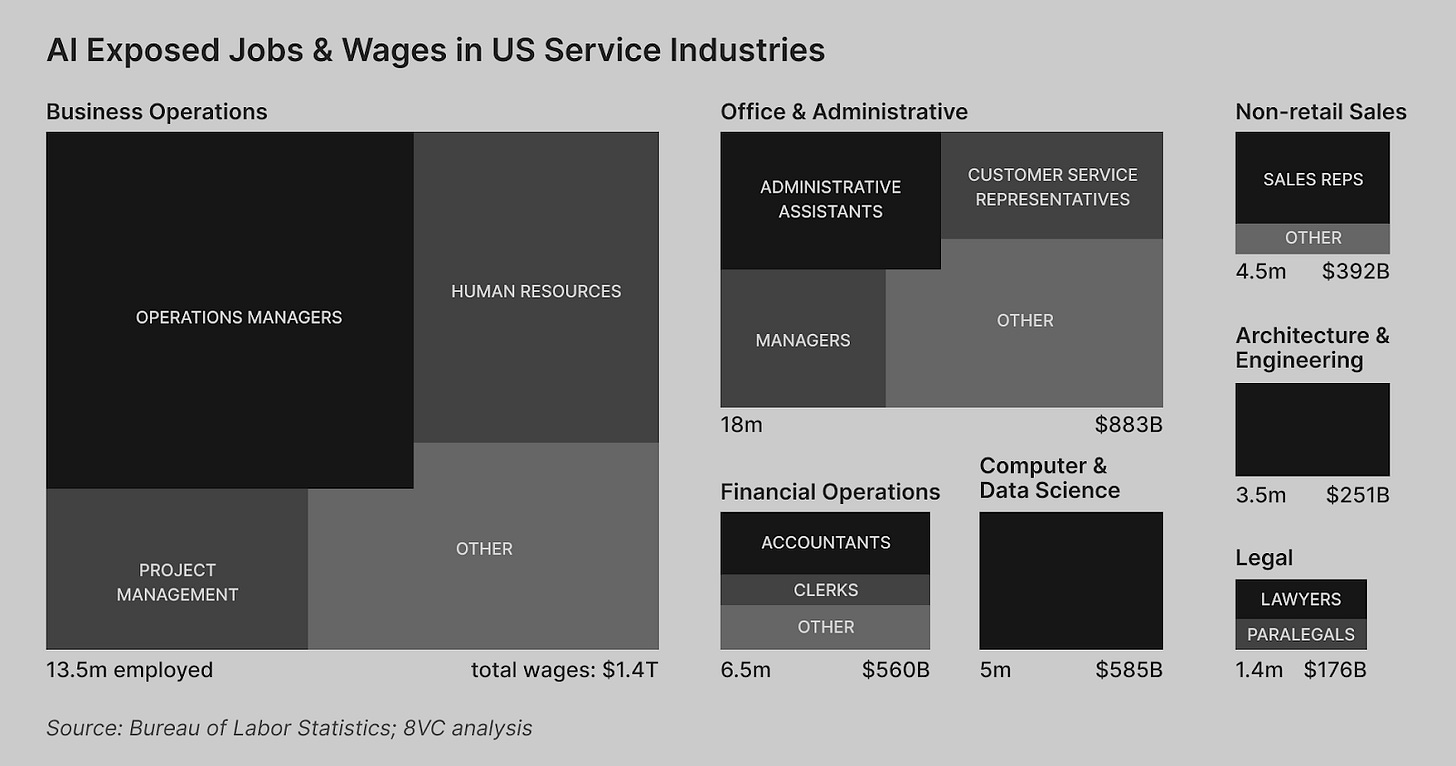A Summer of AI in San Francisco
Reflections on a technology revolution, as seen from 8VC
I’ve been spending a lot of time out in San Francisco this summer with our 8VC team, and it's been energizing to meet truly impressive founders building at the frontier of AI. At 8VC, we always evaluate companies by first asking: Why now? The best answers highlight clear technological shifts that unlock entirely new products & solutions that were previously impossible but are now strategically necessary.
Over the past decade, many enterprise SaaS companies succeeded by focusing narrowly and building products for specific verticals, niche user segments, or overlooked workflows. This approach has produced great businesses which thrive precisely because they are specialized, capturing vertical data and improving their workflows.
Recent advances in AI like document understanding, reliable legacy software automation, conversational agents, and structured reasoning dramatically expand the range of tasks software can execute directly. Instead of merely assisting workers, software today can autonomously work alongside them, managing complex workflows. Founders are now confidently transforming how entire departments work.
Our Frameworks
When people ask about investing in AI, we share a simple framework to help them understand all the options, and where value accrues in the AI ecosystem, organized into six tiers, 0-5:
Tier 0: Energy Infrastructure – critical to support and scale the entire AI ecosystem.
Tier 1: Chips – the fundamental hardware, GPUs, and specialized processors powering AI compute.
Tier 2: Data Centers – the physical infrastructure and computing environments that host and scale AI workloads.
Tier 3: Foundation Model Companies – organizations building large language models and AI capabilities, such as xAI, OpenAI, Anthropic, Google, and Meta.
Tier 4: Software Infrastructure – tools and platforms that enable the deployment, orchestration, monitoring, and management of AI models (e.g., vector databases, orchestration platforms, model hosting services, Palantir).
Tier 5: AI-native Applications & Services – use-case-specific software that directly automates and executes entire workflows, moving beyond simple assistance, and full-stack services offerings that close the loop when AI can’t solve the task on its own. Often competing directly with existing businesses in the services economy (e.g. healthcare billing agencies).
The companies in Tier 3 making foundation models — like OpenAI, xAI, Anthropic, etc — are able to compete in the basics of Tier 4 (software infrastructure): vector stores, tool calling, memory, and other software fundamentals. This makes it difficult to compete in pure infrastructure. We will still fund heavy lifts by the best teams in areas like developer tooling, but the strength of the foundation model companies means that our attention climbs up to Tier 5 and AI-native apps.
Here, software lives inside the workflow and absorbs proprietary data. Companies create a beautiful flywheel as each completed task tightens feedback loops and raises switching costs. Opportunities unlocked in this shift are attracting top talent.
New categories of products & companies are possible because of new fundamental advancements at Tier 3 and Tier 4.
Better Doc Processing - Until recently, extracting structured information from unstructured documents was either unreliable or limited to simple tasks. Today’s LLMs can consistently read dense legal contracts, financial statements, medical records, and operational logs, not just to pull basic information but also to summarize key insights, categorize documents intelligently, and even generate fully formed, contextually appropriate drafts.
Intelligent Browser Automation - A significant share of business-critical data and tasks resides behind non-API, legacy systems. Historically, automating these interactions meant fragile web scraping or manual effort. Modern AI-driven browser automation products like Kaizen have become robust and reliable enough to safely extract data, navigate complex user interfaces, and complete workflows end-to-end with minimal human oversight.
Voice and Conversational Agents - Previously, interactions requiring nuanced conversational capabilities such as customer support calls, internal employee assistance, or vendor negotiations resisted effective automation. New voice and text agents can follow sophisticated multi-step instructions, adapt conversationally to specified edge cases, and handle critical operational tasks directly, reducing the need for human intermediaries.
Each of these capabilities represents a powerful step forward on its own -- combined, they enable new shapes of automation. Instead of helping employees carry out workflows, these new systems can directly execute them. They become agents within an organization, performing tasks, making decisions, and driving meaningful productivity gains at scale.
These breakthroughs unlock vast areas of greenfield opportunity. Tasks that once demanded armies of specialists -- or were simply skipped -- are now fair game for intelligent software. Workflows that used to be manual, costly, or error-prone can finally run at machine speed and accuracy.
When we look at investment opportunities at 8VC, we begin by looking closely at what these new capabilities allow software to achieve. Categories defined by:
High volumes of repetitive, document-centric tasks;
Workflows reliant on legacy interfaces and portals;
Knowledge-heavy tasks requiring judgment and decision-making, but where process is in place or extractable.
What's working?
One of our clearest proofs that the world has changed is our portfolio company Cognition, which rethinks how software engineering work gets done. Software development has long relied on humans for every high-judgment step – reading requirements, creating tickets, writing and reviewing code. Tools shaved minutes, never hours or days. Cognition’s AI agent, named Devin, now reads a spec, writes code, opens a pull request, and manages feedback. Some of the largest & fastest-moving software teams run Devin in production. The result is not incremental productivity; it is a new unit of work that no longer needs a person.
We’re also backing AI Applications that leverage these new Tier 3 capabilities to systematically replace and transform entrenched workflows across major enterprise spend categories.
Outset rethinks qualitative user research. Their system moderates user interviews, asks follow-ups, and synthesizes insights in real time. What would take a research team days or weeks can now be done in a single afternoon. AI interviewers can run for < $1 a session and costs on multi-modal inference continue to drop each model cycle.
Glimpse starts with retail deduction disputes – a painful, error-prone process that most brands handle manually or not at all. They automate the full dispute process, then expand into adjacent workflows like trade promotions and financial ops. These deductions can be 20-30% of a brand’s revenue, and 10% of those are winnable. AI can take back a whopping 2-3% of GMV, which changes the lives of these low margin CPG businesses.
Ground Control focuses on regulated manufacturing, starting with first-article inspections and building into other core document workflows in the back office. Every single regulated part needs these reports, and delayed reports can hold up revenue for weeks, sticking a profitable shop underwater.
Tezi is building an AI-native recruiting platform. Their system sources candidates, engages them, evaluates fit, and moves them through the funnel, executing an entire recruiting workflow with minimal human input. Global recruiting spend burns > $200B a year while software only captures low single digit % of that. Tezi today can shave off 80% of recruiting labor hours in the menial aspects of these workflows.
Broad-based automation is also central in our AI Services investments, where well-designed AI systems replace many functions and increase productivity by a multiple in legacy businesses.
Sequence Holdings acquires and transforms IT services businesses by embedding AI into core code generation workflows and ops, reshaping how managed IT services scale and deliver value.
Arcos reinvents transactional law practice as a technology-first legal platform, dramatically reducing transaction timelines and increasing margins. This requires a thoughtful understanding of how a workflow actually operates end-to-end, and the many areas to seamlessly involve a human with full context, then share any new context to automate rote work.
Although powerful AI models have made it easier to prototype impressive demos, durable companies in this space are doing something harder: deeply embedding into the real structure of work.
How do we create durable value?
We continue to reference our lessons from Palantir (which we wrote a bit about in The AI Services Wave), where understanding the ontology of a domain was essential to designing effective software. Mapping out the workflow – what can be automated, what should be augmented when model capabilities improve, and where humans still need to stay in the loop – is the foundational step. When done well, this informs not only what the product should do, but also where the moat will come from.
The best systems today are also designed to improve with each use. When an AI system handles a scheduling call or a negotiation, it captures new edge cases, learns preferences, and updates its internal rules. These rules persist. They create operational knowledge that grows over time. Agents like Cognition’s Devin and Tezi’s Max are good examples. Each pull-request-review or sourcing pull creates a new data point that sharpens future performance and increases switching costs. We see a similar ontology lock-in here that parallels previous waves of SaaS best practice: domain-specific agents capture the canonical data model and decision logic for the job. A challenger can’t simply “plug a model” into the workflow; it would need years of edge-case history to match accuracy.
While what AI can do now enables products like Devin & Max, much of the ~$4T “AI-exposed” services economy (see fig below) still sits beyond the raw capability frontier of current models.
Licklider’s “man–machine symbiosis,” echoed in the Palantir and Addepar playbooks, shows the practical path forward in turning this chart into captured value: pair software with people. Human experts remain in control, applying context and judgment at a higher level of abstraction, while AI handles the rote execution. Our AI-services companies follow this pattern. They embed a human-in-the-loop who flags edge cases, refines standard operating procedures, and uploads years of craft knowledge – whether billing codes, legal clauses, or IT runbooks – into the agent. The result is a 10x to 20x productivity lift for the same team and a compounding data advantage for the product.
We're seeing margins lift today from 10s to the 50s and 60s, and if technology continues to improve at the rate it is now, the margin structure may soon be the same as software is today. Will these margins compress over time with competition? Maybe a little, but there is a lot of hard work, learning, and client-and-industry-specific nuance that create moats and lock-in; we'd be surprised if the margins don't stay a multiple higher than the legacy service businesses we're replacing, even though the clients should end up paying less - and getting much better service!
We’re still early in this wave, but the trajectory is clear. Recent advances at Tier 3 have opened tremendous new opportunities to build enduring companies at the top of the stack. We expect the next generation of enterprise software leaders to emerge from companies that don't just augment workflows, but fundamentally own and execute them at scale.
If you’re building something ambitious that fits this vision, we’d love to talk.





really resonate with this. we're building programmable trust rails for housing and access. replacing agents, brokers, and coordinators with code that just works. not making the old system faster. killing it. the goal is to own execution in the real world the way stripe owned payments. would love to connect if that's what you're building toward.
very active on X - TheAndersonOB
I am studying